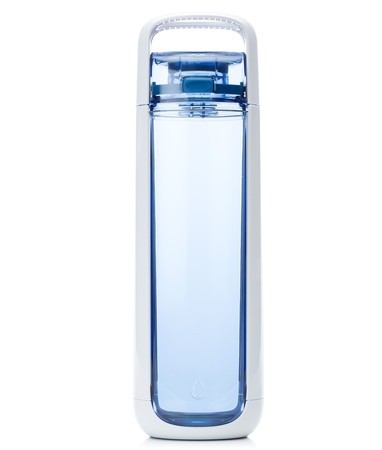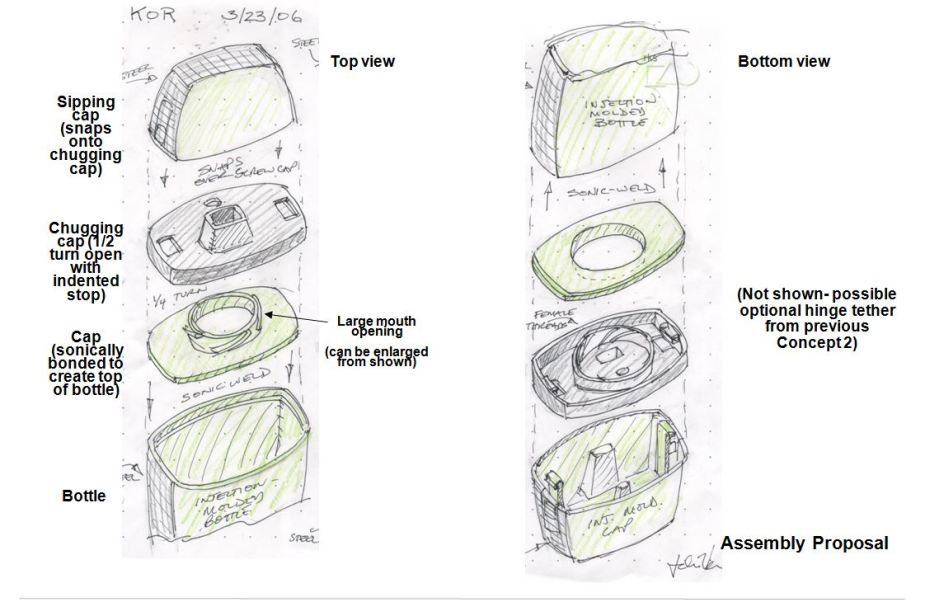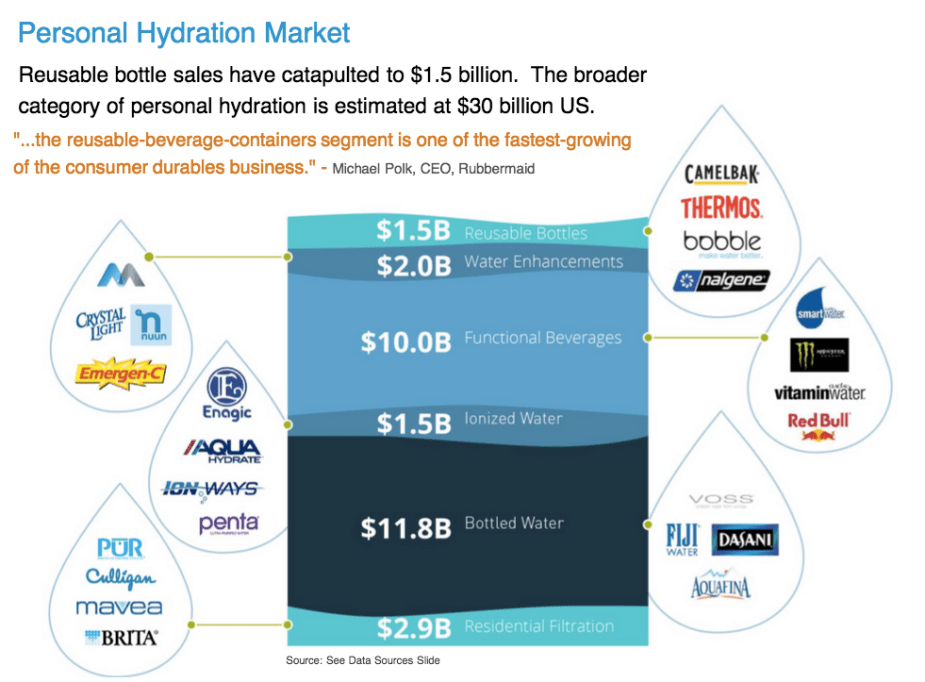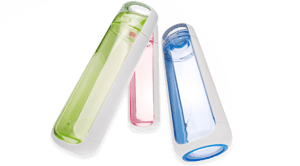Beautiful, enduring design is everywhere. The Coca-Cola bottle, Chuck Taylors, and Le Creuset’s dutch oven all have it. No matter who you are or where you’re from, you’ve probably held at least one of those items in your hands — or one of the many, many knock-offs. Despite constant innovation in packaging, shoes, and cookware, these classic designs have each remained popular for about a century.
KOR Water launched with the same ideals, taking on the humble water bottle and tweaking every minutia of it until they had a drinking vessel so impressive it actually starts conversations.
That first product, the KOR One, is elegantly tall, oblong, and rounded at every corner. The lip is curved with a smooth, cantilevered spout — the first without threads. The lid itself, which hinges back at the touch of a button, protecting the spout in a hygienic bubble. The KOR team approached their first bottle like it was software, with a hundred specs they had to meet before the KOR One was ready for customers.

Inspiration for the perfect water bottle came to Eric Barnes gradually. At first he was just looking to buy a reusable water bottle, to stop his contribution to the proliferating piles of plastic that to choke landfills everywhere. He searched stores top to bottom, only to find camping canteens and soft bladders, readymade for backpacking but hardly stylish. Barnes wanted a beautiful bottle, something that was as much a piece of great design as a practical container, something that would stop people and spur them to talk about water, plastic, and sustainability. Together with his co-founder, Paul Shustak, Barnes spent three years perfecting the bottle, sketching and prototyping until the product launched in 2008 and proceeded to win half a dozen design awards.
Over a phone interview, Barnes described his rigorous design process, how he navigated the manufacturing world for the first time, and why doing both direct-to-consumer and retail are essential for a company like KOR.
Did you intend to spend years on the first bottle?
Not exactly. My cofounder, Paul, came from a product management background at Microsoft — He worked on Encarta, and some other very successful products. Paul was all about research and SWOT analysis, so we came at it like KOR was going to be software. We had all these requirements, a hundred specs that the bottle had to have. Designers will tell you not to do that because it’s not a software product, but ultimately I think it was a real touchpoint, bringing industrial design into a category that had been pretty sleepy.

How did you approach product and market validation?
Paul was all about frameworks whereas I was really intuitive about what KOR was going to be, and it was a great co-founder relationship, because he kept pulling us back to having some rigor in our approach. We did a little market research; We went to a mall and asked people a bunch of questions about their water consumption. We showed them prototypes. We annoyed the hell out of a couple of people in the food court who were trying to eat their lunch. It was no fun and while I think it was somewhat useful, at the end of the day people will tell you what they think, but not really what they want.
And we were underground for three years. So the funny thing is when KOR launched we weren’t ready to deliver the product. But I was afraid of losing the window of opportunity, so in June of 2008, I released a story about the KOR One hydration vessel, our first product. It was months ahead of being available.
And the press picked it up?
It tipped, it was everywhere. It was on BoingBoing, Gizmodo, Endgadget, and then it propagated to New York Times and Businessweek. All of our work was immediately validated. But we had no product to show, so that created a lot of pressure. We spent the next four months just debugging and by the end of the year we were finally shipping product.
Did you have experience in manufacturing before KOR?
None. We both came from software, and you know, it’s a lot harder to change atoms than bits. If you have a problem, you’re dealing steel molds, not a line of code. You have to deal with quality control, you have to have inventory, you have to ship the product. And I didn’t know anything about industrial design. I didn’t speak the language. But I knew what I wanted, and I was able to convey this idea.
How have you approached growth?
We’ve taken this organic approach to growing KOR, we’re not in a rush. Until this last year, we were entirely an inbound sales organization. International distributors, retailers, even co-branding opportunities would come to us. But we now have a sales team and the reason is: in US retail you have to go to the right trade shows and you have to engage the sales reps and service retail accounts. And so in the last year or two we’ve really focused on retail and how we’re going to grow KOR as a brand.

Can you talk a little about your experience in direct-to-consumer versus retail?
Since we started off as a niche, premium brand, we were behind our own direct business from the beginning. That has allowed us to understand the margins in a way we wouldn’t otherwise. It also allows us to experience the brand with our customers and get feedback. So doing direct-to-consumer is critical for us. But it doesn’t have to be exclusive, and the reality of it is our product needs to be in retail. Retail has tremendous value for what we’re doing; it lets customers see and touch the bottles. It’s phenomenal what a difference it makes when you can actually pick up the product.
How did you seed the company with capital?
My co-founder and I seeded the company with our life savings. We bootstrapped it all the way until about a year ago when we took out a small convertible loan. So with the CircleUp round, this is our first real outside capital. We waited as long as we could. It was always about just hitting the next milestone; We’d hit a milestone, and we’d say, “We should go out and raise money.” But then, we’d stretch it a little further to increase the value of the company. We did that for a long time.
What’s the plan for the capital you’re aiming to raise in this round?
The market is growing massively right now. Reusable bottles, filter bottles — it’s all growing and there are big CPG companies that are getting into it. In a way, what we’ve done is a prologue for what we need to do now. We’re looking to scale in a big way. We’ve been at this for five years. So we’ve already made our mistakes, we’ve fine-tuned our business, we’ve nailed our product line, we’ve done all the tweaks. Now we’re ready. We’ve got a product road map that’s just incredible, so this round of capital is the fuel we need to get this going.
Can you give us a peek at the road map?
We’re looking at the complete spectrum, competing against Brita and other filtration companies. And we’re looking at enhancements. We’re looking at packaged beverages, figuring out how we’re going to take on Vitamin Water. It’s possible.

Anything in a package can be done in a sustainable way.
And if it’s in a beautiful design, consumers will respond.
That’s right. Every liquor company, every perfume company knows that the bottle is the brand. Design is very much at the heart of why people buy those products.
